Premier League has every season brought up shocking results, teams and players. This campaign hasn’t been the exception. With Liverpool, Chelsea and Manchester United having an irregular start with very poor results and performances after 15 games, teams like Newcastle United have taken advantage of these situations to show off their amazing and hardly-worked football style that comes from an intense, purposeful, direct and beautiful game that has helped them win 30 points, winning eight matches, drawing six and losing only one in 15 games played. A really amazing tally and run of performances that started since the arrival of Eddie Howe, who has turned massively the image and spirit of the squad.
On the other hand, Chelsea are still adapting to Graham Potter‘s principles, functions, roles and ideas, as well as his constant change of shapes and formations that keep his teams confusing to analyse and defend. Lately, they have been very slow with the ball, and unable to break rival pressures or lower blocks that close down the spaces to run or create fast touches on the ball to arrive at the box.
This past Saturday, in the last Premier League matchweek before the start of the 2022 World Cup in Qatar, they faced each other at St. James’ Park, resulting in a 1-0 impressing victory for Newcastle. Both of them arrived at this match at really different moments. Newcastle has recorded five consecutive wins and were on a 10-game unbeaten streak since they lost 2-1 against Liverpool at Anfield. Chelsea have recently been the polar opposite of them, going six games without a win, a tough moment for Potter and his staff.
In this tactical analysis, we dive into the tactics of both teams and see how Eddie Howe’s Newcastle won the tactical battle against Chelsea.
Lineups
Eddie Howe went with his preferred 4-3-3 and his typical back-four composed of Nick Pope on the goal, Kieran Trippier, Fabian Schär, Sven Botman and Dan Burn. In front of them, Bruno Guimaraes played as the deep-lying-playmaker, the role who fits in perfectly, accompanied by Joe Willock (LCM) and Sean Longstaff (RCM) who were very important in the attacking third creating overloads on the outside and exchanges of channels that confused Chelsea’s marker. Up front, Howe decided to go with Joelinton (LW), Chris Wood through the middle and fashioned-boy, Miguel Almirón (RW).
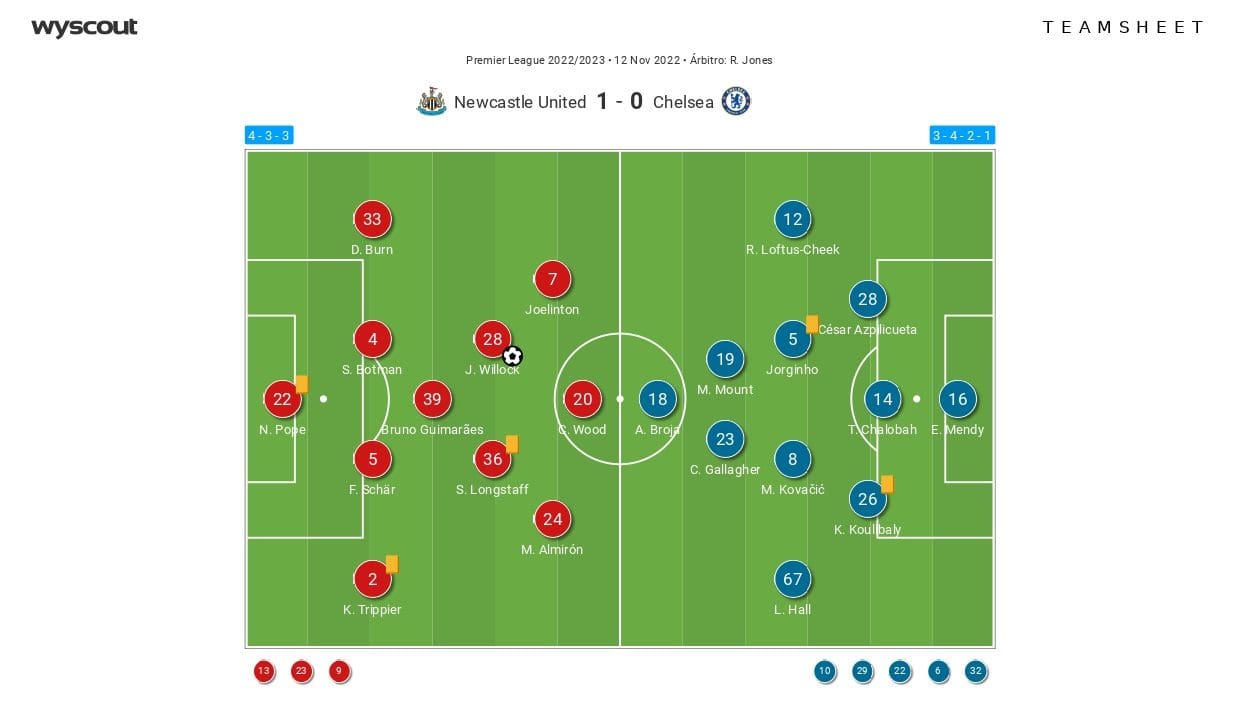
Graham Potter picked, as well, one of his typical shapes, and a common one that Chelsea had used with Thomas Tuchel in past years, the 3-4-2-1 with narrow wingers that were closer to being a double ’10’ rather than wingers.
Edouard Mendy came back into goal, and the back-three was formed by Kalidou Koulibaly, Trevoh Chalobah and César Azpilicueta, nonetheless, this was modified in the 5th minute as Ruben Loftus-Cheek (RWB) picked up an injury and Thiago Silva replaced him, with César Azpilicueta the one who took the RWB spot. Lewis Hall grabbed his first start in the Premier League, and Mateo Kovacic (LCM) and Jorginho (RCM) set up the line, with the mentioned substitute over the right. Mason Mount (LAM), Conor Gallagher (RAM) and Armando Broja (CF) completed the starting eleven.
Intense high pressure on Chelsea’s centre-backs
Entering the tactical set-up of the game, Newcastle United wanted the game to be played in Chelsea’s own third, They apply intense and tight pressure, especially on centre-backs, who were forced to execute long balls without destination, turning into another possession of the ‘Magpies’. However, it wasn’t only worked to make them throw the ball long, but also playing it wide to his full-back who then had to make tough decisions as midfielders were all tightly-marked.
The display was usual and repetitive in all of Chelsea’s possession sequences, however, it wasn’t that easy for the ‘Blues’ to escape it and made it very difficult to avoid awkward situations that resulted in ball losses and counter-attacks for Howe’s side.
What we can see below is the pressure applied by Newcastle in the match, a very high set-up in the rival box, with tight markings on the centre-backs. As we can see, the man on the ball in this picture is Thiago Silva who’s been put under pressure by Chris Wood. Over on the right, Miguel Almirón is closing down the space for Kalidou Koulibaly. On the left, Joelinton has the most important defensive role from the three-man forwards. He has to run for the centre-back, Chalobah, being attentive if an inside pass to Jorginho is taken, and if the ball is played wide, he has to go and mark the wing-back, Azpilicueta.
Behind the three-strikers was another key element of Newcastle’s pressing. Longstaff and Willock went high on the pitch to close passing options to midfielders and force players to go outside or take a long pass.
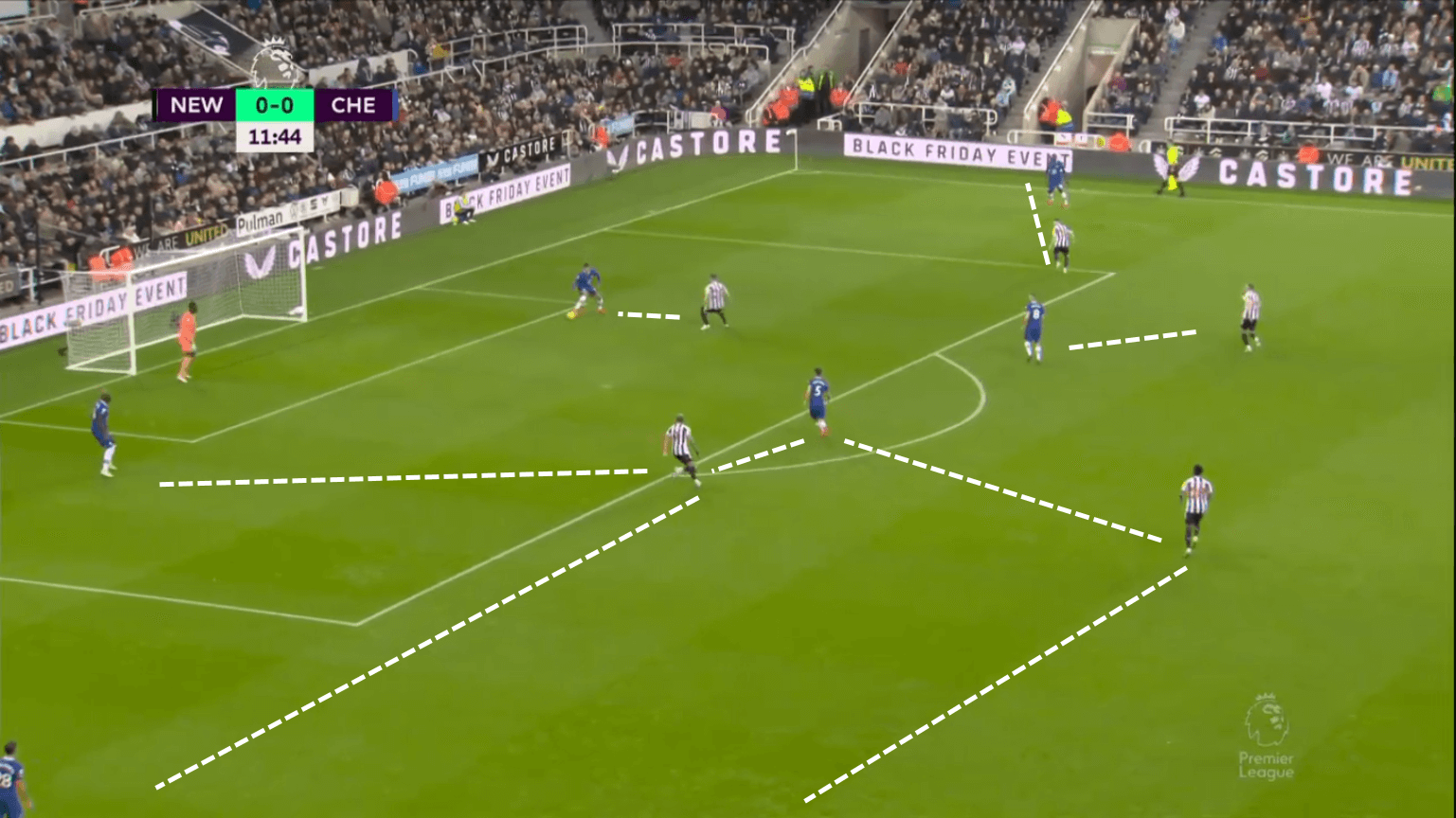
Once again, we can see the pressing disposal of Newcastle being very aggressive but with tactical coordination to pull the triggers in the right moments, which can get players closer to rivals and force mistakes in dangerous zones.
Another example: Chelsea were down to ten men here as Loftus-Cheek was off and Thiago Silva was waiting to go in. Jorginho entered as a centre-back and Gallagher dropped deep to join the midfield line, however, Joelinton’s pressure over Chalobah was incredibly tough after a poor pass from Mendy who was marked by Chris Wood. On the other side, Koulibaly wanted to get closer to the strong side of the ball but was also accompanied by Almirón, who didn’t leave him alone at any moment. This play ended in a pass from Chalobah to Jorginho who under pressure tried to find Azpilicueta but the pass was poor and forced it go out for a Newcastle throw.
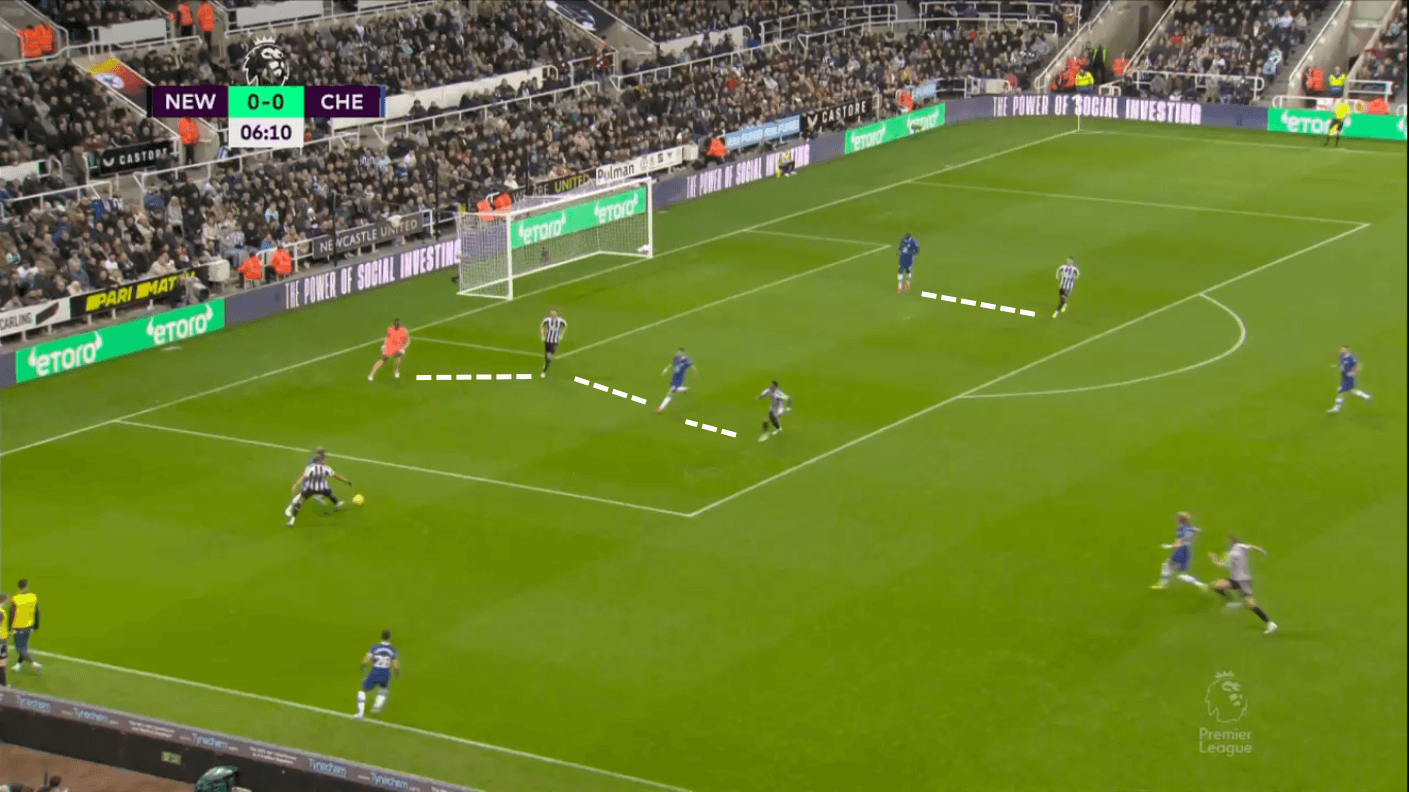
See how close were Newcastle trying to playing against Chelsea. They wanted to clearly recover the ball as high as possible, so they even put three players inside the rival box when the ball was played from the goalkeeper to a centre-back.
In this sequence, Almirón leaves Koulibaly on the outside to press Thiago Silva, the ball-holder. Joelinton was marking Mendy who gave the pass to Silva. Wood tracks back to take Jorginho and this ended in a very bad pass from the Brazilian centre-back who under pressure couldn’t connect nicely with Koulibaly.
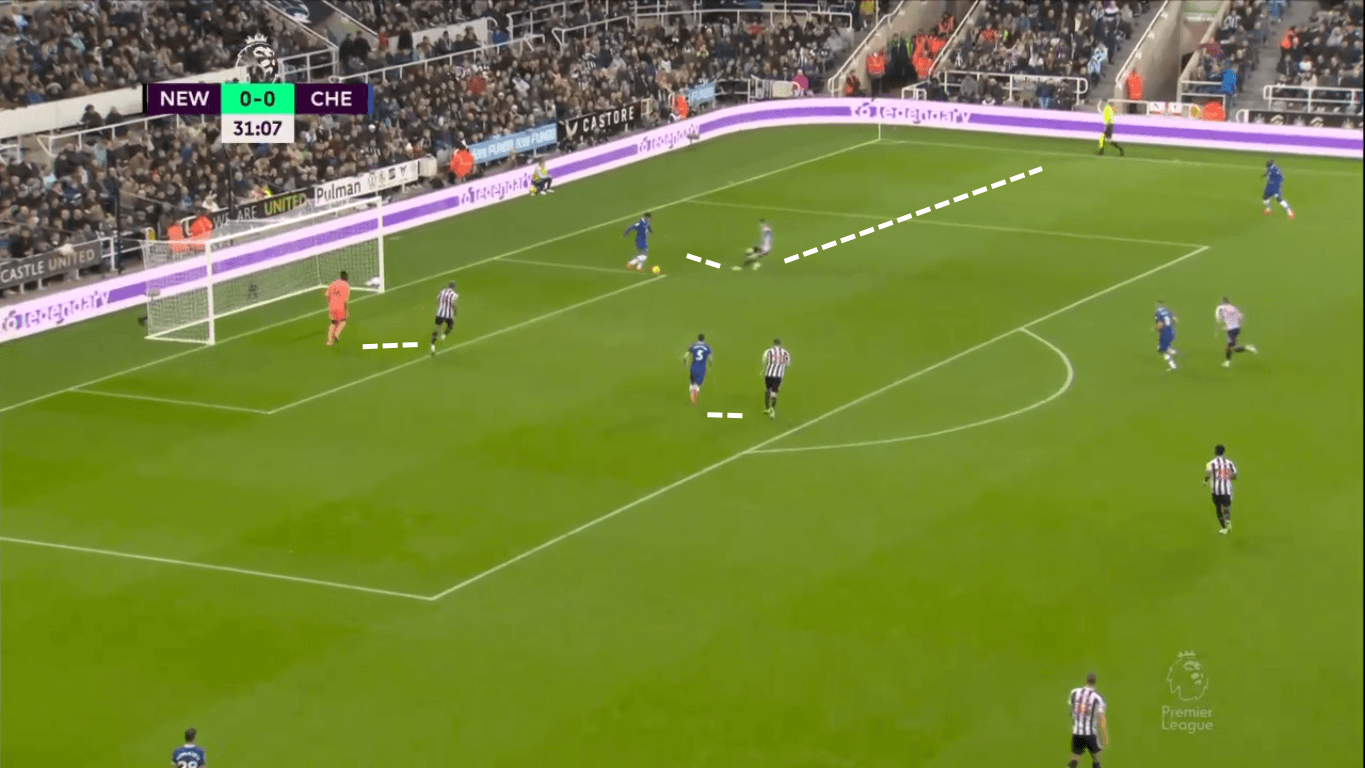
Newcastle also pressed very close even if Chelsea was trying to move their block into more advanced heights of the pitch. And the setup was still the same, although, one of the side-midfielders in this case was more aggressive and proactive to leave his man behind and go to the man on the ball. This is to give him time to think and then press the trigger to put him in a nervous situation.
This picture describes it perfectly. Wood and Joelinton are still marking the centre-backs but on the strong side of the ball. Longstaff and Almirón exchange who they have to defend. The midfielder goes for the centre-back and the winger blocks the passing option with LWB, Lewis Hall.
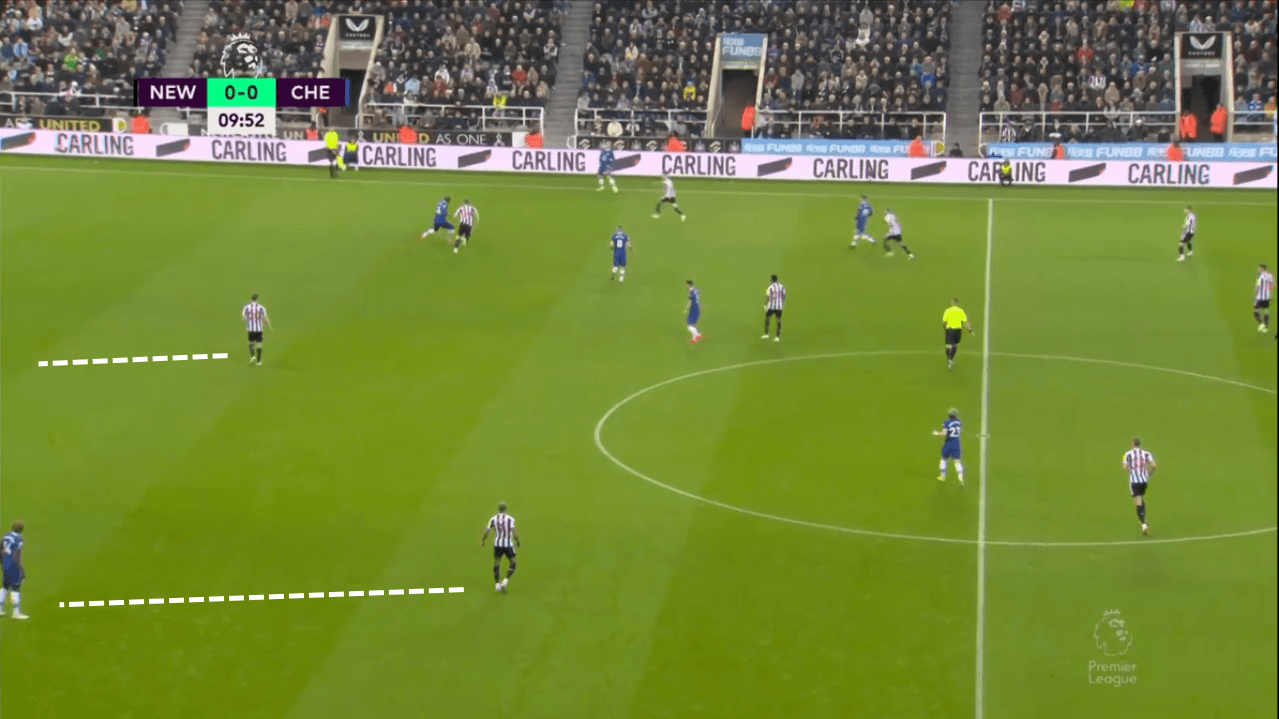
Nevertheless, Chelsea did break this high-pressing from Newcastle United, and here are some methods of how they did escape. Utilization of Edouard Mendy as an extra man to create numerical overloads, attract the pressure and execute chipped-balls to his wing-back.
These are normal and successful passes against high-pressing systems, however, Chelsea were so stressed after being forced so many times in these moments, that the inaccuracy was a regular sight.
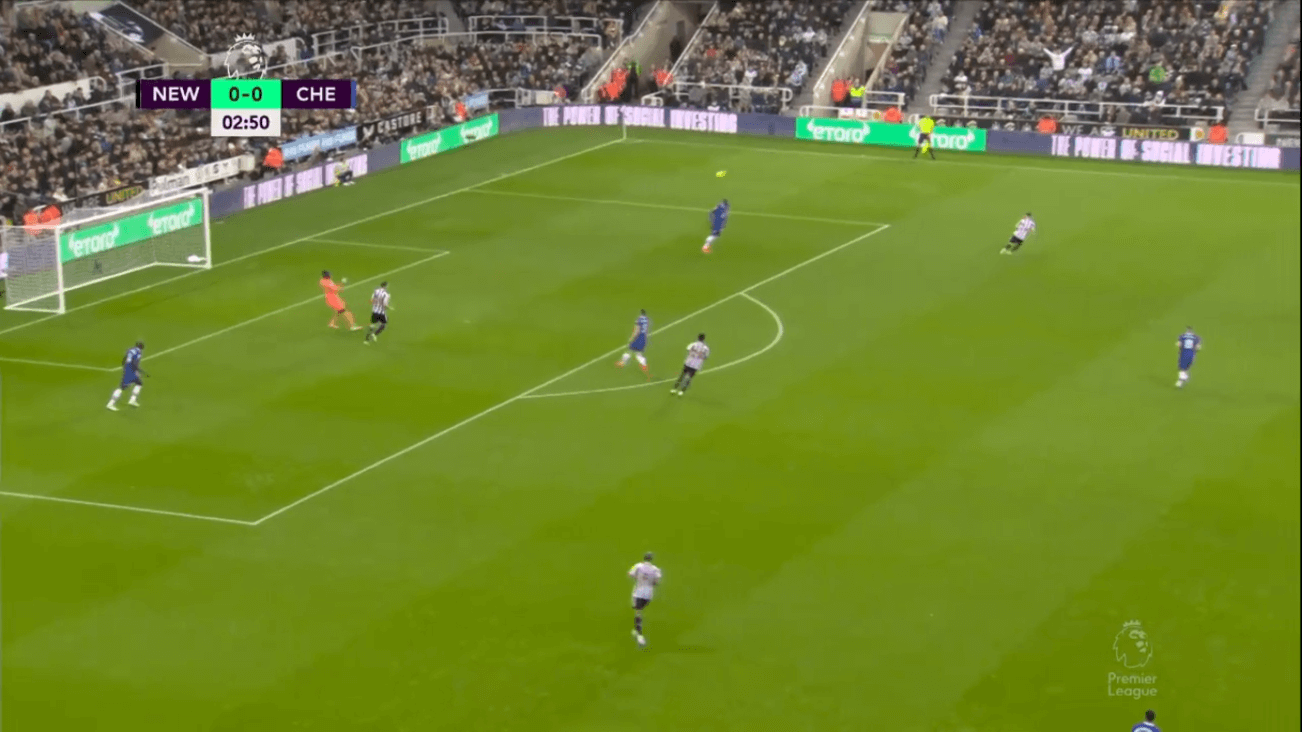
Another method Chelsea used to break Newcastle’s pressure was the exchange of heights from the double-pivot, which saw Kovacic take elevated positions on the pitch and not be that positional in front of their centre-backs.
Mason Mount would drop from his zones to then be activated and could carry the ball to then open the wide areas with Hall who was pinning outside.
These were situations that Potter’s team could only do up to two or three times during the match, as Newcastle’s pressing was mainly effective, as well as their rest-defence and the recovery runs from their players.
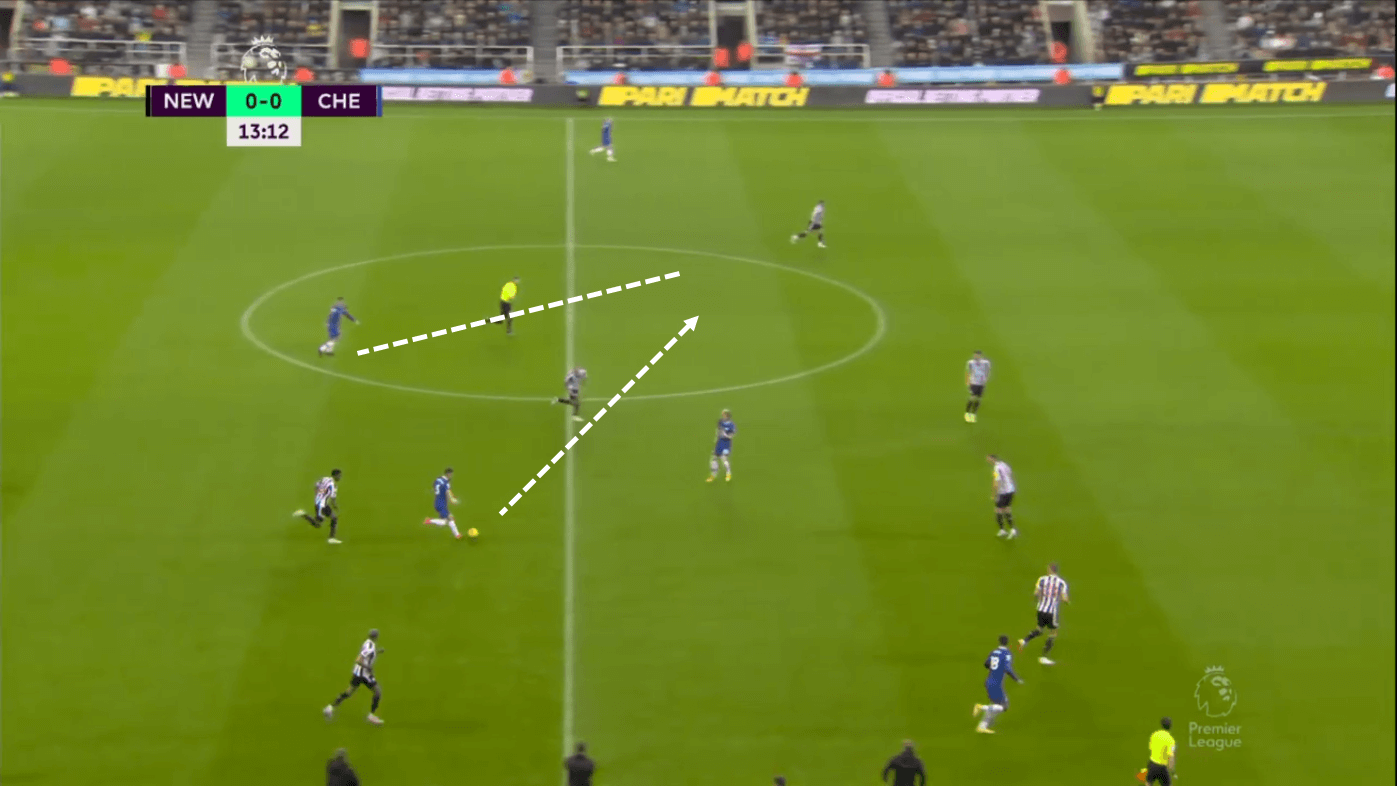
Finally, Newcastle kept the intensity and the high-pressing, but Chelsea modified their shape into a back-four, with Trevoh Chalobah going to the right, as Azpilicueta left the pitch for Pulisic, and Silva-Koulibaly was the centre-back partnership.
Eddie Howe’s team decided to make some changes in their pressing structure, but it wasn’t that much and still was very effective, as Joelinton, Almirón and Wood kept marking Chalobah, Koulibaly and Silva, but with Jorginho joining the first-line of the build-up, Willock was more a ’10’ following the movements of the pivot.
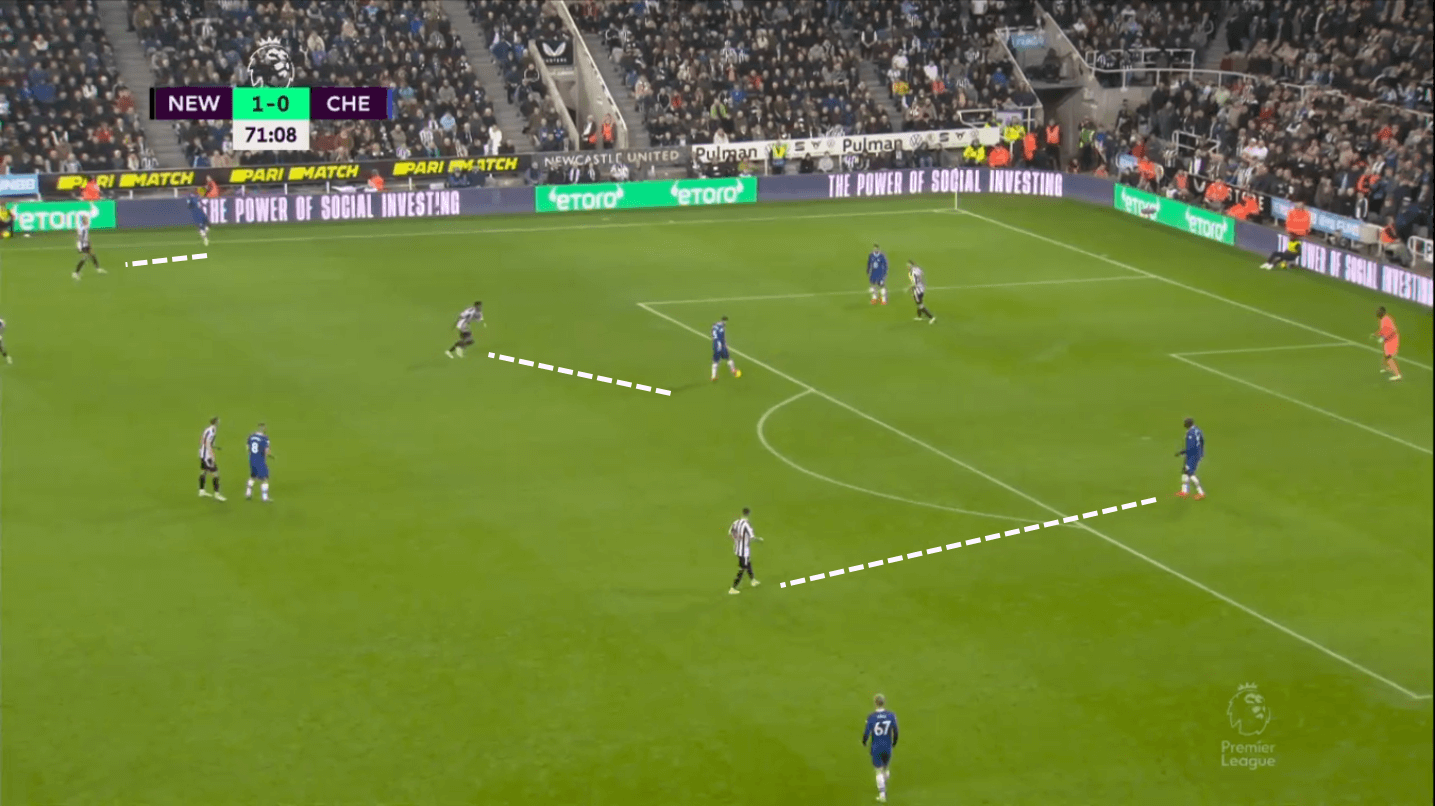
How freely Joelinton helped Newcastle escape Chelsea’s pressure
The Brazilian was once again important for Eddie Howe’s system, not only for what we have seen in the section before talking about his important facet and input in the defensive phase of the game but also for his mobility and understanding of which zones he has to step on to help his team. Newcastle looked to play from behind with their centre-backs on the ball and their goalkeeper being used to create a numerical overload. Besides, Chelsea didn’t look for the ball that high, and the presence of Pope in possession was important to Newcastle to shift the ball to weak sides.
The midfield, including Bruno Guimaraes and Sean Longstaff, both dropped deep to attract Chelsea’s pressure through the middle, and free space on the outside to Kieran Trippier to receive the ball and progress through his incredible associative abilities. However, this wasn’t the only manner to escape the pressure of Graham Potter’s side. As two midfielders dropped down and attracted almost four Chelsea players, Joelinton stayed behind this opposition line to be activated in different ways, but the long ball from the centre-back or first-time pass by one of the pressed-midfielders being the most common ways to find him, who after receiving the ball, turned aggressively looking to connect with Almirón or Willock who were running down the wing.
This is a perfect example of how Chelsea were blocking the midfield but this played out well as Bruno Guimaraes and Sean Longstaff were attracting the pressure and leaving space behind for Joelinton to appear. Mount and Broja were the two men up front, with Jorginho and Kovacic behind setting up like a box, that enclosed the two Newcastle midfielders. However, this wasn’t effective and they broke it in several ways.
In this one, Botman played the pass to Longstaff who under-pressure executed a first-time ball to Joelinton who received and turned it into an attack.
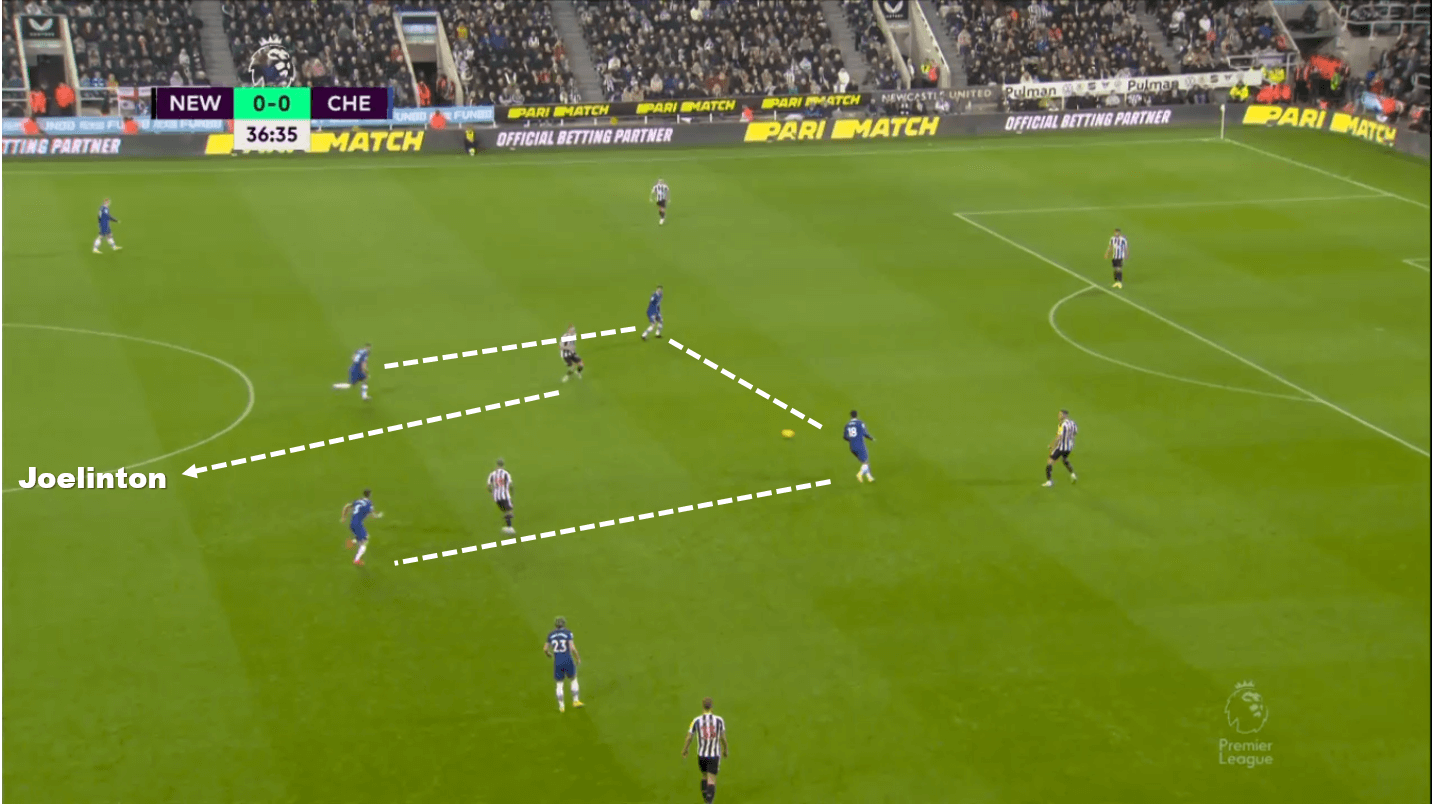
Another time, Bruno Guimaraes and Sean Longstaff were very close to their centre-backs, attracting the Chelsea midfielders who were surprised many times by a long ball from Schär or Botman. In this case, the Switzerland international performed a brilliant pass for Joelinton to receive with time and space to run and take a decision going into the attacking third.
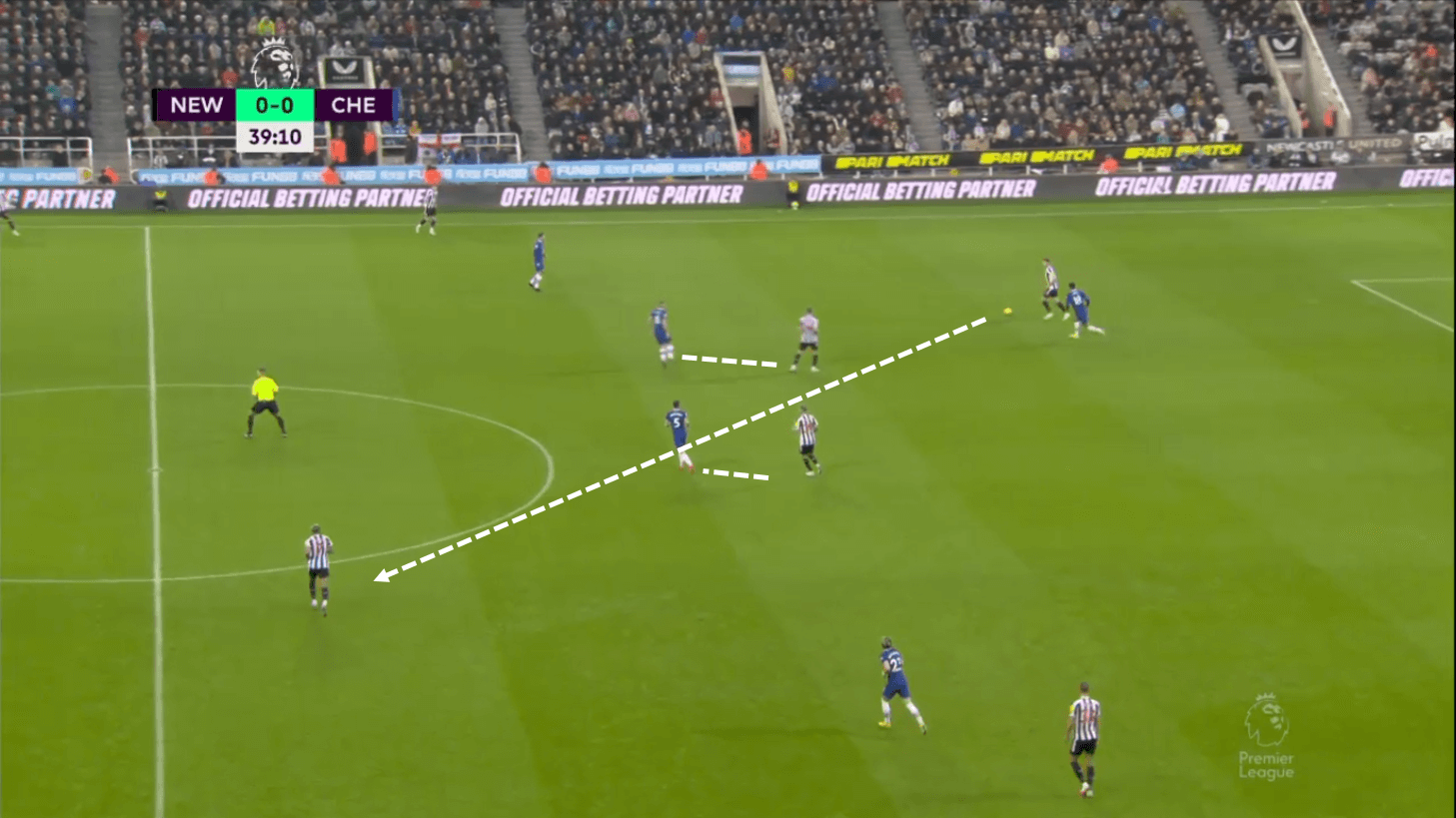
Newcastle also were put under pressure this way to force the pass wide to one of their full-backs, however, this wasn’t that successful as normally the pressure was oriented to the right, where Kieran Trippier received and immediately would look to play a long pass to Almirón behind the rival full-backs, or play it through the middle to one of his midfielders and generate one-two situations. His small-space capacities were showcased and Chelsea couldn’t nick the ball back.
Triangles in attack and the massive input from Willock and Longstaff
Newcastle United tried to make damage to Chelsea’s defence with overloads and triangles over on the wings that included the exchanges of channels between full-backs, midfielders and wingers. It was a usual sign in the first half to see Joelinton going inside, leaving the wide area to Willock who will run there, and Dan Burn joined behind to create numerical overloads and be part of the passing circuit.
In the second half, Chelsea changed their shape to a back-four which saw Trevoh Chalobah as a right-back who was in trouble several times in the match as he didn’t see often support from Gallagher and he wasn’t that fast to stop the 2v1 situations on the flank, as well as not that technically accurate to stop 1v1 duels.
This was exploited by Newcastle who kept with the same disposal, creating wide triangles and exchanging channels constantly between Joelinton and Willock, as we can see below.
Dan Burn played the pass through the half-space to the Brazilian, who spotted the greatly-timed run of Willock in the outside, he then executed a beautiful through-pass that nearly ended in a goal after Willock delivered a cross to Chris Wood.
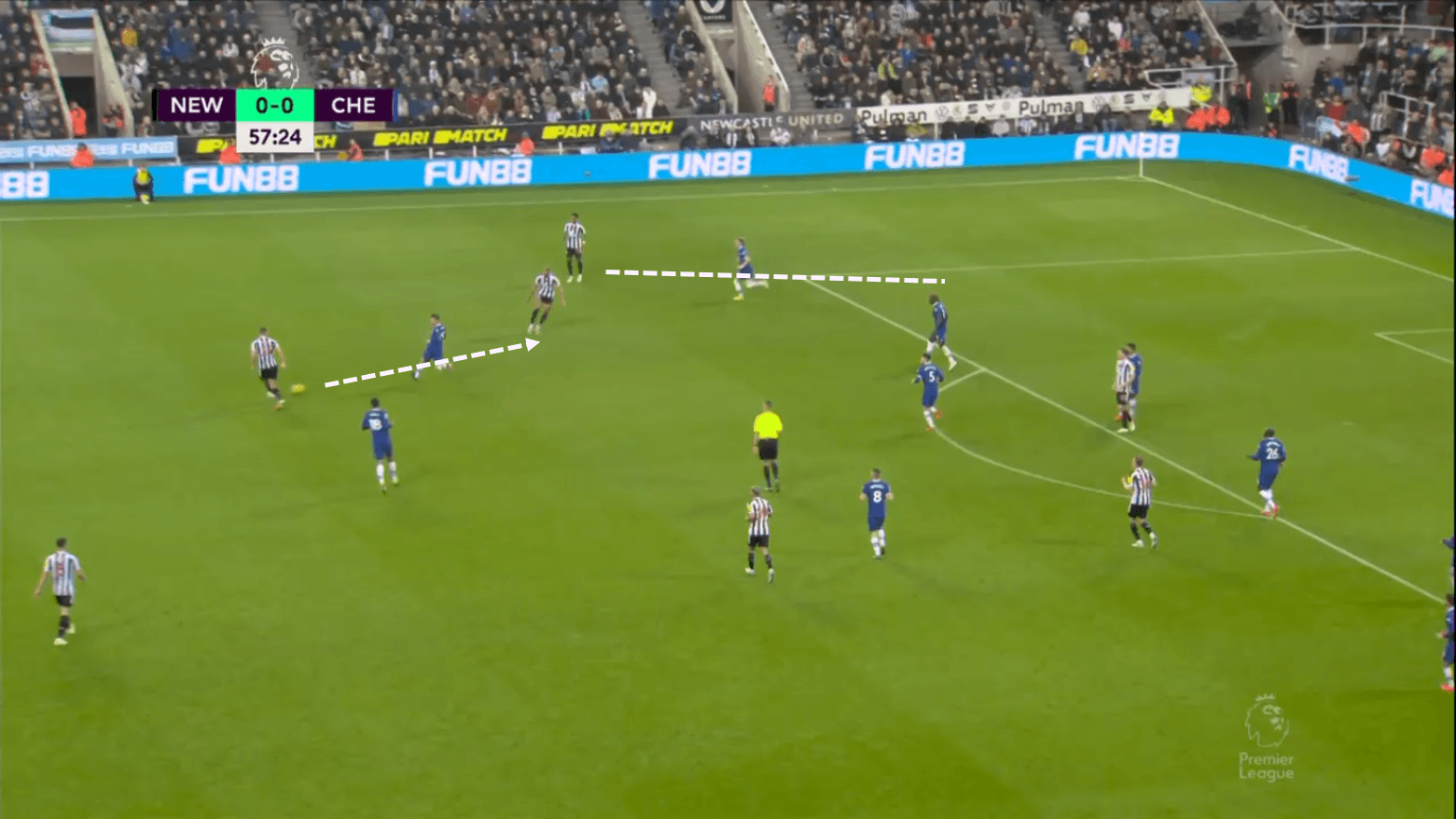
Normally in the first half, Newcastle didn’t look that frequently to create triangles over the right, mostly a tandem between Longstaff and Almirón who also exchanged zones very well. The Paraguayan was very mobile and dynamic during the match and Eddie Howe made another tactical move. He wanted Kieran Trippier higher in the second half, to create even more confusion and rotations over the right flank.
This picture below shows amazingly how they wanted to work out. As Longstaff was the man looking to get wide and crossed, on this occasion, Newcastle pushed Trippier forward to create underlapping runs behind Almirón and with his brilliant technique started to send threatening crosses to the box. Longstaff’s movements were also interesting and intelligent as he dragged players to create space for Almirón to shoot or put crosses into the far post.
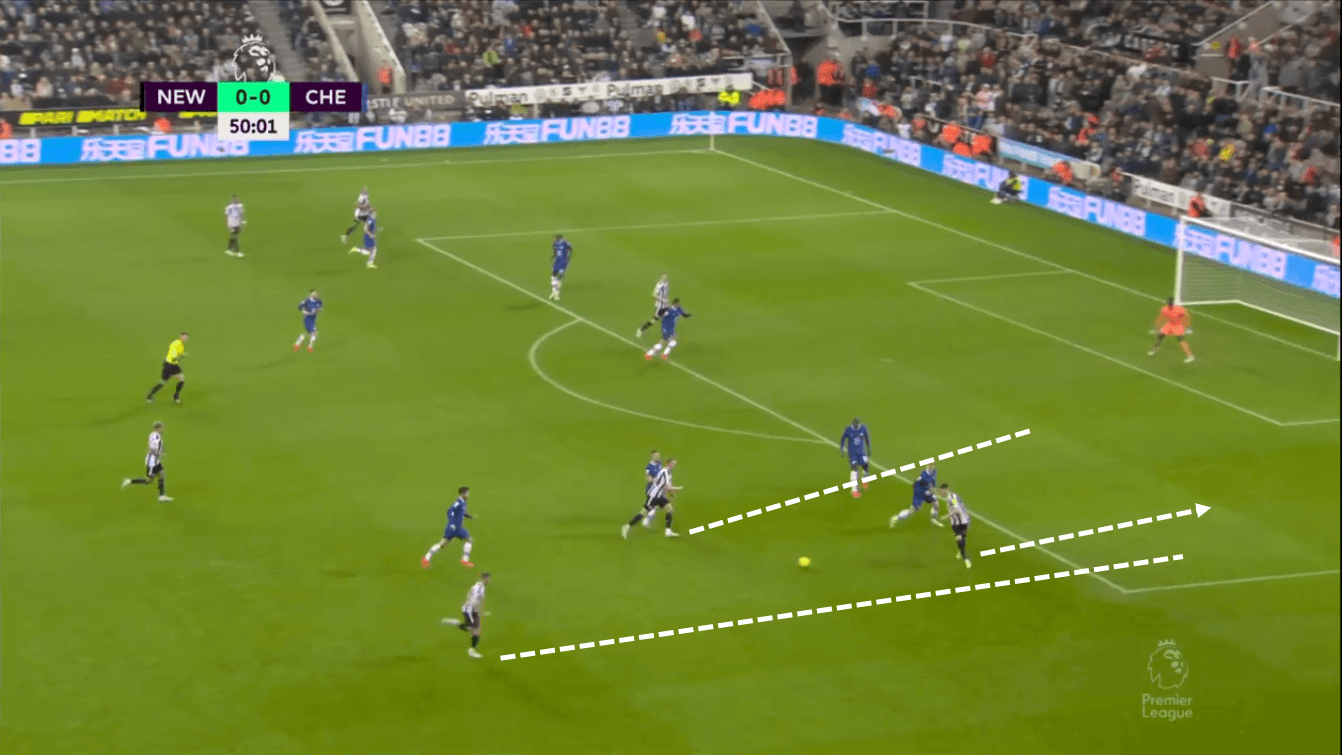
Newcastle created lots of threatening attacks like this, however, it wasn’t this way they scored the goal. But indeed, one of the tactical compositions Howe gave to the team, showed off in the goal, as Joelinton, inside his free role, moved to the right to receive the ball and instantly played a brilliant through-ball to Almirón who ran powerfully to the space to then drive inside and found Willock who scored a magnificent outside-of-the-box goal.
Conclusion
This analysis showed how Eddie Howe’s side dominated the spaces, the ball and several things against Graham Potter during the majority of the match. Newcastle wanted to play in Chelsea’s third, and they did. When they had possession, they were a threat. When they defended, they did it hard and blocked Chelsea’s ability to break them down, and when they looked to exploit spaces and re-adjust shapes and tactical movements, they did it well.
It was a perfect win for Eddie Howe, as he grabbed the three points and his team put in a massive performance.






Comments